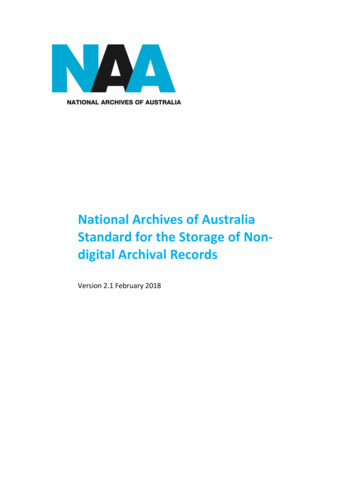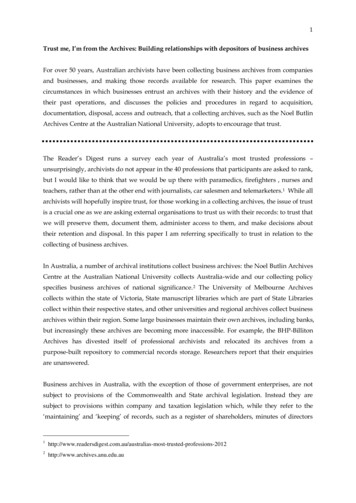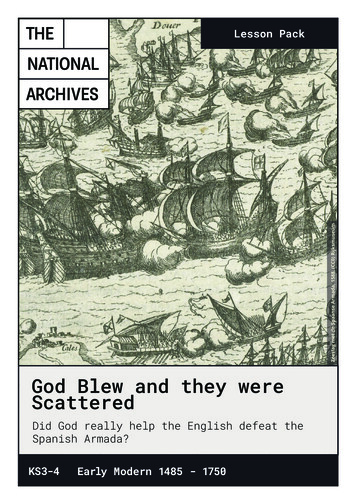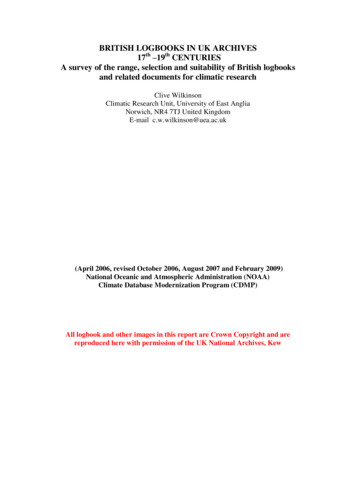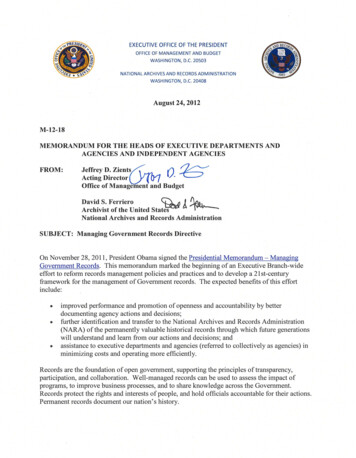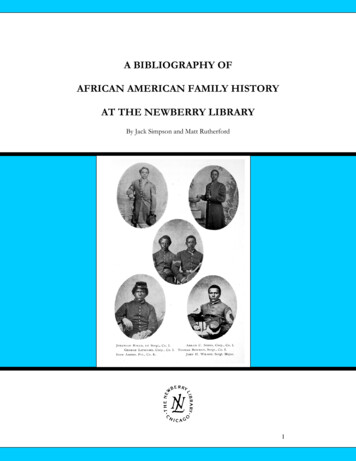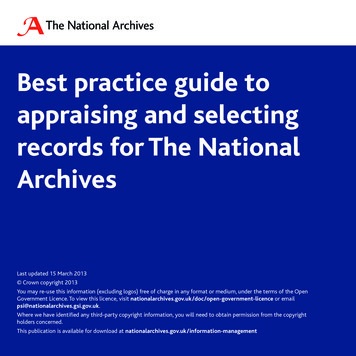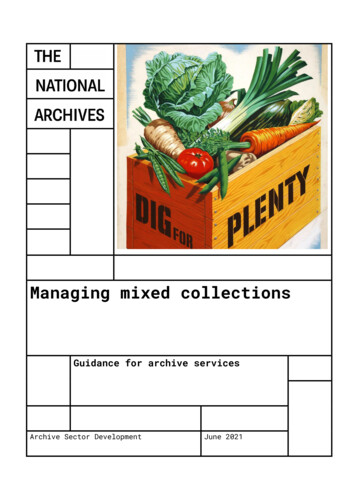
Transcription
THENATIONALARCHIVESManaging mixed collectionsGuidance for archive servicesArchive Sector DevelopmentJune 2021
The National Archives – Managing mixed collections for archive servicesContents Contents.21.2.3.Introduction.51.1Introduction to this guidance .51.2Purpose and scope of the guidance.51.3Why manage mixed collections .6Overview of the Museum Sector .62.1Overarching museum standards.72.2Introducing Spectrum.72.3Where to go for specialist help .10Organisational Health.113.1Mission and governance .113.2Forward Planning .123.3Resources: Spaces and storage .133.4Resources: Workforce.153.5Liaison with museums.163.6Ethics and Legislation - Overview .19Ethics and Legislation - Collecting contemporary history: events andmemorials .283.74.23.8Ethics and Legislation - Managing human tissue.303.9Ethics and Legislation – Provenance and the Legalities of collecting .333.10Valuation.363.11Insurance.37Collections Development .394 .1How to decide whether you are an appropriate custodian.394.2Contested Heritage and decolonising collections.414 .3Acquisition and Accessioning.424.4Deaccessioning and disposal .454.5Assessing significance.46
The National Archives – Managing mixed collections for archive services5.6.7.Collections Care and Conservation .495.1Storage and Packaging for mixed collections – what’s important?.495.2Location and Movement control .555.3Transport .575.4Loans .605.5Security.635.6Marking and labelling .655.7Pests .685.8Handling.725.9Hazards .755.10Conservation .805.11Emergency planning – how does it vary for mixed collections? .835.1 2Listed buildings and sites.85Guidance for working with specific collection types .866.1Food and alcohol.906.2Chemicals.926.3Metals.936.4Weapons .986.5Costume and textiles .1026.6Plastics.1086.7Leather .1136.8Wood .1196.9Architectural Models.1246.10Material from performing arts .1256.11Large objects .1286.12Human remains .1316.13Art collections - Sculpture .1366.14Art Collections – Oil Paintings.1396.15Framed items .144Collections Information.1487.13Cataloguing objects in archive collections.148
The National Archives – Managing mixed collections for archive services8.Stakeholders and their needs.1508.1User Access in reading rooms .1508.2Developing exhibitions .1518.3Digitisation of 3D objects .1548.4Audience development and interpretative planning .1568.5Managing the use of collections as set dressing .1608.6Managing handling collections .1618.7Mixed collections during unplanned service closures .1639.Case studies.1699.1 Anglesey Archives and Oriel Môn: Collaboration between the archiveand museum .169Canterbury Cathedral Archives and Library: Managing workingcollections.1719.29.3The Mountain Heritage Trust: A people centred approach .1739.4Wordsworth Trust: Why do we collect?.1749.5De Montfort University: Cataloguing Mixed Collections .1769.6Unilever: Soap to Soup: collecting consumer habits .1779.7Tottenham Hotspur Football Club: Guardians of heritage assets .1809.8 .18210.4Appendix – Glossary.183
The National Archives – Managing mixed collections for archive services1.Introduction1 . 1 Introduction to this guidanceThis guidance was written in response to demand for support from the archivesector, particularly from archive professionals that were asked to manage nonarchive heritage collections, often without the necessary skills and knowledge. Insome organisations, archive professionals are the only staff members with aheritage background, and this results in them being given responsibility formanaging any heritage item, irrespective of format. Our aim is to supportprofessionals in this position.This guidance doesn’t support archive professionals having responsibility for themanagement of large heritage collections but recognises that situations willarise when smaller heritage collections are managed by archive professionals.This document was produced by a team of archive and museum professionals:Janice Tullock, Anita Hollinshead, Heather Lomas and Mairead O’Rourke. Archiveprofessionals across the sector supported the development of the work byproviding interviews and participating in discussions. Particular thanks are givento the Section for Archives in Museums of the Archive and Records Association.1.2 Purpose and scope of the guidanceThe guidance will help archivists and archive service managers to explore theissues around managing mixed collections and to effectively manage thesecollections. It provides an overview of sources of help and advice and signpostsexisting good practice and standards. Following the structure of the ArchiveService Accreditation Standard, the guidance provides advice on generalmanagement of these collections, including ethics and legislation; collectionsdevelopment, care and conservation and information; the needs ofstakeholders, particularly access and interpretation.In each section we aim to: Introduce the problem/potential of the subject matter.Outline the principles to be applied.Highlight specific areas of importance.Provide links to sources of more detailed guidance and relevantstandards.Each section provides standalone advice, while cross-referencing other sections.5
The National Archives – Managing mixed collections for archive servicesDefinitionsThe definitions used in this document align closely to Archive ServiceAccreditation, with the addition of some which have been written for thisdocument. A detailed glossary is in the appendix.1.3 Why manage mixed collectionsManaging mixed collections can present a variety of problems and risks,particularly when collections staff do not have the knowledge or experience toeffectively manage the full range of material in their holdings. Possible scenarioscould include managing dispersed art collections without a detailed knowledgeof the recommended approaches. In other instances archivists have unwittinglystored objects in damaging environmental conditions or packaged items in waysthat may cause damage.The research for this guidance identified one instance where this had expensiveresults for the organisation. A company managed a mixed collection, including awide range of materials and formats. Although they had policies and proceduresin place, they did not have the necessary depth of knowledge of the collectionsto manage these materials effectively. A lack of understanding of the significanceof materials led a collection of books to be used as “set dressing” for a roomwithin the company. The value of the books was recognised by a staff memberwho stole the books and offered them for sale. The subsequent policeinvestigation created unnecessary work for the archive service and difficultiesfor the company. If the archive service had recognised the significance and valueof the books, they would not have been used in this way.2.Overview of the Museum SectorManaging mixed collections requires partnership with experts in the museumsector and for this reason we are beginning this guidance with a brief overviewof the sector and how it might help you to manage your mixed collections.The museum sector in the UK is varied but includes national, civic, independentand university museums. Nationally styled museums are funded by Departmentfor Digital, Culture, Media & Sport and are generally large institutions holdingcollections that are of national importance. Civic museums can be run by town,parish, borough, city, or county councils and other Local Authority bodies andgenerally hold collections that reflect local heritage. The independent museumsector is also varied in scope, size and activities. The Association of IndependentMuseums (AIM) states that there are 1600 independent museums, the majority6
The National Archives – Managing mixed collections for archive servicescovering specialist subjects such as military issues or industrial heritage and athird having a general nature. University museums usually hold collectionsrelevant to academic specialisms. Overall the UK has more than 1700 accreditedmuseums. It is important to note that Museums have each site accredited, incontrast to archive services that tend to have a whole service accredited.2. 1 Overarching museum standardsSeveral key museum standards are effective the UK museum sector: Museum Accreditation Standard. Spectrum the UK Collections Management standard. EN 16893:2018, covers specifications for new buildings and themodification of existing buildings intended for the storage and display ofall heritage collection formats. PAS 197:2009 Code of practice for cultural collections management.2.2 Introducing SpectrumOverviewSPECTRUM 5.0 is the UK Collections Management Standard and its contents andrecommendations provide archive professionals with some guidance onmanaging mixed collections. It is maintained for the sector by the CollectionsTrust and its 21 procedures form the basis for best practice for working withmuseum collections. Spectrum 5.0 is mapped directly to the MuseumAccreditation Scheme. This guidance recommends the use of Spectrumprocedures for mixed collections where the Archive Service has no relevantpolicy and procedure. These procedures will be noted throughout the guidance.There are nine primary procedures which museums meet as part of theMuseum Accreditation Scheme; these procedures are the ones museums usemost frequently.The Spectrum 5.0 nine primary procedures are: Object entry – Logging all objects coming into your care for whateverreason, including loans, enquiries and potential acquisitions. Acquisition and accessioning – Taking legal ownership of objects,especially (but not always) to add to your long-term collections through7
The National Archives – Managing mixed collections for archive servicesthe process of accessioning: the formal commitment by your governingbody to care for objects over the long term. Location and movement control – Keeping a record of where all theobjects in your care can be found and updating the location each time anobject is moved. Inventory – Making sure you have the basic information to be accountablefor the objects in your care and tackling the backlog if you do not. Cataloguing – Managing the information that gives your collectionsmeaning, not as an end in itself but to record and retrieve what is knownabout your objects. Object exit – Recording when objects leave the buildings you areresponsible for and pass out of your direct care. Loans in (borrowing objects) – Managing objects you borrow for a fixedperiod of time and for a specific purpose. Loans out (lending objects) – Assessing requests for you to lend yourobjects and managing the lending process until loans are returned to you. Documentation planning – Making your documentation systems betterand enhancing the information they contain as an ongoing process ofcontinual improvement.The remaining procedures are: Condition checking and technical assessment – Documenting the makeup and condition of objects and noting any resulting recommendations. Collections care and conservation – Managing and documenting anyconservation work on particular objects, such as treatments to slowdecay, repair damage or improve appearance. Valuation – Documenting the financial value of objects, whether your ownor borrowed. Insurance and indemnity – Ensuring your own objects, loans and otherobjects left in your care have appropriate cover against damage or loss. Emergency planning for collections – Managing information aboutpotential risks to all the objects in your care, and the action to be taken inemergency situations. Damage and loss – Responding to damage to, or the loss of, objects inyour care.8
The National Archives – Managing mixed collections for archive services Deaccessioning and disposal – The formal decision by a governing body totake objects out of its long-term collections (deaccessioning) andmanaging the disposal of those objects through an agreed method. Rights management – Managing the intellectual property rights and dataprotection rights associated with objects, reproductions and information. Reproduction – Managing and recording the creation of images and otherkinds of reproduction of objects, including digital copies. Use of collections – Managing and recording how your collections,including images and other reproductions of them, are used, whether byyou or anyone else. Collection review – Managing and documenting any formal assessment ofyour collections that follows a stated methodology. Audit – Systematically checking the accuracy and completeness of theinformation you have about your um/spectrum-5/Particular issues to consider for mixed collectionsArchive Services holding mixed collections will find the information contained inSpectrum 5.0 useful in developing policies, plans and procedures whichencompass the range of collections they manage.Many of the procedures are similar to procedures archive services will developto manage collections.In developing procedures for mixed collections archive services should aim tocombine standards from the Spectrum 5.0 with archive standards, thusproducing an effective and applicable hybrid procedure. To ensure consistencyin managing archives and mixed collections a procedural manual should bedeveloped and maintained.Principles to applySpectrum 5.0 defines a standard for each procedure and also provides thestructure and framework for development of procedures. This is useful as a tooland one to consider when adapting archive service procedures to encompassmixed collections.As described by the Collections Trust, each procedure has: A definition that tries to sum up the procedure in a single sentence.9
The National Archives – Managing mixed collections for archive services A fuller note on the scope of the procedure, which explains when to use it(and, at times, when to use a different procedure). The Spectrum standard. This is what you should aim to achieve, howeveryou do it. There are two parts to the standard:o Some policy questions you will need to consider.o The minimum requirements you should meet in your museum’sown written procedure. An example or two suggests why each isimportant. A suggested procedure (and it is only a suggestion) given in two formats:o A workflow diagram summarising the suggested way of doingthings.o A text version, which includes the information requirements forthe procedure. Where needed, the text versions of suggestedprocedures also include guidance ctrum-5/Standards to considerSpectrum 5.0 Collections Management Standard for seum Accreditation hemeArchive Service rchives-sector/archive-serviceaccreditation/2.3 Where to go for specialist helpUnderstanding the ecology of the museum sector is important when managingmixed collections as it will help you to find sources of help and advice, identifywhen items might be better housed in a museum service and to tie intomuseum standards and guidance. For our purposes there are five mainorganisations that can provide specialist help: Arts Council England (ACE);Museums, Archives and Libraries Division of the Welsh Government (MALD);10
The National Archives – Managing mixed collections for archive servicesCollections Trust; Association of Independent Museums (AIM) and the MuseumsAssociation.Further detail of the roles of these organisations is in the section on MuseumLiaison.3.Organisational Health3 .1 Mission and governanceOverviewArchive Service Accreditation places the mission of your governing organisationat the centre of your planning for your Archive Service and your collection. Itdescribes the intent of your service and should define your purpose in everyaspect of your archive management. Arrangements for governance enable youto ensure that you are achieving your mission and helping to deliver the overallaims of the organisation.Particular issues to consider for mixed collectionsThe mission of the service is an important consideration for mixed collectionsbecause it provides an opportunity to describe your role at the highest level. Insome organisations the management of mixed collections sits naturally with thearchive service and your mission should be written to reflect this. This will helpto secure the necessary resources to manage the collections within your careand fully reflect the role of the archive service.Alongside a clear mission, including a role for mixed collections, it is useful toadvocate for both your service and its role. Advocacy is important in themanagement of mixed collections, particularly articulating your collecting policyand its limits. It is useful to develop a clear message about your collecting policy,to inform people within the organisation about that policy and to work acrossthe organisation to share that message. To prevent confusion it is good to avoidthe use of technical language when describing the scope of the policy and toprovide examples of the types of material you collect.Useful resources and websitesThe National Archives: Raising the Profile of your Archive ts/archives/effectivecommunications.pdf11
The National Archives – Managing mixed collections for archive services3.2 Forward PlanningOverviewA relevant and practical forward plan sets the strategic direction for the archiveservice. It is an active document containing clear aims and objectives and adelivery plan to enable effective monitoring of operations. It is supported byessential financial planning, resources and budgeting to ensure the plan isdelivered.The forward plan is the central part of the Archive Service AccreditationStandard which in the guidance document (page 16) states‘SignificanceThe forward plan is concerned with execution and delivery. It is the route bywhich the mission of the archive service is achieved through the practicalmanagement of the service. Forward planning is a useful exercise for a service ofany size. It gives an opportunity to lay out the objectives you want your serviceto achieve and to plan what needs to be done to get there’.Particular issues to consider for mixed collectionsIssues to consider include: The forward plan should inform the service’s response to all therequirements of the Accreditation Standard i.e., Organisational Health,Collections and Stakeholders.The forward plan aims, objectives and delivery plan should adequatelyreflect the breadth and depth of the collections.Ensuring the forward plan maximises the opportunities available forenhanced access and research, that is possible with holding mixedcollections.Maintaining sufficient skills and experience within the workforce tosupport the work with mixed collections and ensuring the forward planrecognises when additional expertise is required.Providing sufficient resources are available to resource the storage,display, access, care and conservation needs of mixed collections.Principles to applyForward planning involves setting realistic strategic aims and objectives for thefuture. To meet the standard for Archive Service Accreditation a plan is requiredwhich covers a minimum term of the current and subsequent years.Development of the forward plan provides a time for reflection on theeffectiveness of a previous plan, including how the archive service is developing,what is working well and where challenges may be. This is also the time and12
The National Archives – Managing mixed collections for archive servicesopportunity to consult stakeholders on the aims and objectives for the future. Ifthe archive service holds mixed collections, this will be the time to consult withexternal colleagues, particularly with museums which may have overlappingcollection areas or hold similar or related collections.Standards to considerThe Archive Service Accreditation Standard and guidance provides usefulguidance and information for developing an effective forward plan.It may also be helpful for archives to consider the requirements of the MuseumAccreditation Scheme guidance for forward planning.Useful resources and websitesArchive Service Accreditation, -guidance/Museum Accreditation Scheme, ult/files/downloadfile/Accreditation Guidance Mar 2019 0.pdfAssociation of Independent Museums Success ts Council fNational Lottery Heritage Fund Business Plan ice-guidance/business-plantemplate-and-guidance3.3 Resources: Spaces and storageOverviewDetailed guidance on the physical storage requirements of mixed collections isdealt with below. This section looks at what you might need in terms of thestability, suitability and sufficiency of your spaces and storage.13
The National Archives – Managing mixed collections for archive servicesParticular issues to consider for mixed collectionsIn an ideal world a mixed collection would have storage that is suitable for eachcollection type. This would include separating materials likely to cause damageto other materials, or materials with greater fire risks. You might also need tostore materials in different environmental conditions. Specific guidance can befound in the sections on these materials below. However, in all but the mostspecialist archive stores (e.g. a distiller holding a large collection of whiskey)collection stores will be mixed and not specialist. In these instances therecommendation is to isolate different types of materials that might causedamage to each other in different areas of storage and to understand theimpact of environmental conditions on each material. See the sections below onguidance for each material. As with archive materials you should also aim for agenerally stable environment with little change in fluctuation of temperatureand humidity.Mixed collections tend to bring issues of size to archive management that havenot previously been an issue. Storage areas should not only have spaces bigenough to store items safely, but should have doorways large enough to safelyallow movement of items. Storing large items within a store often requiresspecific storage furniture and the Museum of London resource below is useful inproviding guidance. You may also need specialist equipment to move objectsand a goods lift if storage is not on the ground floor. For artworks you shouldconsider specialist gallery shelving systems on walls or in mobile racking. Finallyif your collection grows and you seek specialist off-site storage for collectionsyou should consider how you will continue to manage this collection. You shouldconsider how you will manage risks to the collection on an ongoing basis.Further guidance is available in The National Archives guidance on ManagingSplit-Site Services referenced below.Finally, a mixed collection requires spaces for access. This might be access tostudy, to participate in engagement activities or to exhibit objects. Spacesrequired will vary according to the collection, but your planning should considerissues of size, safety and security. It may be that access to the objects is betterprovided digitally and the Collections Trust blog below offers some suggestions.Useful resources and websitesMuseum of London, Packing Museum Objects for al Museums Greenwich, Behind the scenes: how we store large textiles.14
The National Archives – Managing mixed collections for archive ections Trust, 6 tips for increasing access to museum -tips-for-increasing-access-to-museumstorage/The National Archives, Assessing and managing the risks of split-site k/documents/archives/split-site-services.pdf3.4 Resources: WorkforceOverviewAs with the management of any heritage collections, it requires skills andknowledge to care for mixed collections. In particul
The value of the books was recognised by a staff member who stole the books and offered them for sale. The subsequent police investigation created unnecessary work for the archive service and difficulties for the company. If the archive service had recognised the significance and value of the books, they would not have been used in this way.



